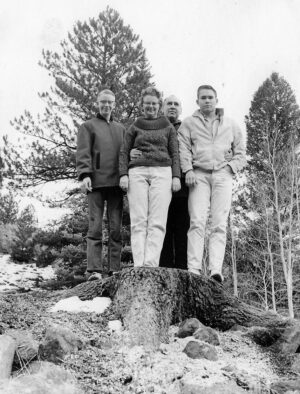The Poncha Springs Fire Station, located at the intersection of U.S. Hwy. 50 and U.S. Hwy. 285, is the fourth property featured from the Chaffee County Historic Resources Survey. As stated by Virginia McConnell Simmons in The Upper Arkansas, A Mountain River Valley, Poncha Pass was part of a hub of trails leading in and out of the southern end of the San Luis Valley. The pass, at an altitude of 8,945 feet, is one of the lowest in the state. In 1779, Comanches retreated over Poncha Pass with stolen horses while being pursued by 600 Spanish dragoons. Arizona Governor Juan Bautista de Anza led the soldiers in a chase ending just south of Pueblo, where the Comnache leader, Cuerno Verde, and other high-ranking tribe members were killed. The hot springs area just a mile from the present town was a favorite campsite for the Ute tribe.
From 1840 to 1860 trappers, hunters and mountain men passed through the area and were soon followed by prospectors. The town, first called South Arkansas, then Poncho Springs, was platted in 1879 and by the early 1880s received new impetus from stage and wagon traffic over the Otto Mears toll road, completed in 1875. The arrival of the railroad and mining combined to spur continued growth. The Neely Mining and Smelting Company, not yet in operation in 1881, would process ores for neighboring mining camps. The Poncha Springs Hotel, built in 1878, was bought four years later by H.A. Jackson and assumed its current name, Jackson Hotel. A small library, bank, post office, store, restaurants, school house and church were constructed. According to O.L. Baskin in History of the Arkansas Valley, Colorado, published in 1881, Poncha Springs “… enjoyed all the excitement and suffered all the terrors incident to being the terminus of a railway in the midst of a mining camp. The extension of the road (to Maysville) relieved the town of the disturbing elements, and it has again become the most quiet and delightful of summer resorts.” In 1882, fire destroyed most of the business district. In the late 1800s, two other fires devastated more of the town.
[InContentAdTwo]
It was more than seventy years later in 1954 that Lawrence Bender, a private citizen of Poncha Springs, purchased the first fire truck. His house had recently been damaged by a fire that destroyed the home of his next-door neighbor. Eleven years preceding this fire, three other homes had burned. According to Shaputis and Kelly in A History of Chaffee County, Bender first read the ad for a used 1947 International fire truck in a Denver paper. Bender and Mayor Ted Holman made the trip to Denver to inspect the fire engine. Bender bought the truck for $2,600 the same day. It held 300 gallons of water, pumped 150 gallons a minute and came complete with hoses, ladders, axes, pike poles and various other equipment. Once back at home, a demonstration of the truck’s capabilities persuaded the town to buy the vehicle, with Bender carrying the financing. The truck now needed a building to house it. A lot was donated by Mrs. Inis Saunder, whose house had recently burned. Volunteers built the two-bay fire station that still stands today. Lawrence Bender was appointed fire chief, a position he held for 23 years. In 1978 firefighters were trained more thoroughly, and a more effective department was developed. The twelve-member Poncha Springs Volunteer Fire Department was formed in 1981. The department is currently part of the Chaffee County Fire Protection District, which includes four fire stations and 58 volunteers. The fire house continues to serve its purpose of housing firefighting equipment and supplies.
The building is important to the survey due to its political and governmental association with the effort to acquire a fire engine, create a fire department and build a fire station. The architecture is typical of a midcentury small-town fire station, reflected by the front gable roof, concrete block walls, and symmetrical facade dominated by two large overhead doors to allow for fire vehicle storage. The building is a tribute to the committed volunteers that came together to make the fire station a reality, as well as the valiant firefighters who continue to serve the county today.



